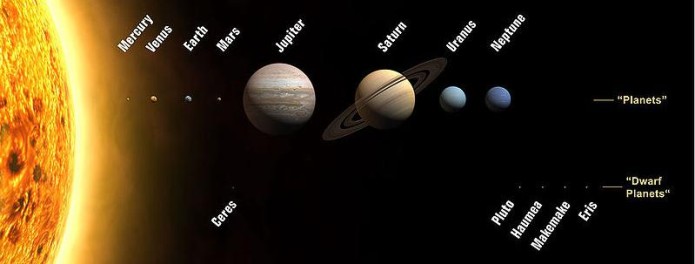The Sun is a star found at the center of the Solar System.
It makes up around 99.86% of the Solar System’s mass.
At around 1,392,000 kilometres (865,000 miles) wide, the Sun’s diameter is about 110 times wider than Earth’s.
Around 74% of the Sun’s mass is made up of hydrogen. Helium makes up around 24% while heavier elements such as oxygen, carbon, iron and neon make up the remaining percentage.
Light from the Sun reaches Earth in around 8 minutes.
The Sun’s surface temperature is around 5500 degrees Celsius (9941 degrees Fahrenheit), so pack plenty of sunscreen if you plan on visiting (remembering that the average distance from the Sun to the Earth is around 150 million kilometers).
The Sun’s core is around 13600000 degrees Celsius!
The Sun generates huge amounts of energy by combining hydrogen nuclei into helium. This process is called nuclear fusion.
 Because of the Sun’s huge influence on Earth, many early cultures saw the Sun as a deity or god. For example, Ancient Egyptians had a sun god called Ra while in Aztec mythology there is a sun god named Tonatiuh.
Because of the Sun’s huge influence on Earth, many early cultures saw the Sun as a deity or god. For example, Ancient Egyptians had a sun god called Ra while in Aztec mythology there is a sun god named Tonatiuh.The Sun produces a solar wind which contains charged particles such as electrons and protons. They escape the Sun’s intense gravity because of their high kinetic energy and the high temperature of the Sun’s corona (a type of plasma atmosphere that extends into space).
Planets with strong magnetic fields such as Earth manage to deflect most of these charged particles as they approach.
A solar eclipse occurs when the Moon is between the Sun and the Earth.
While we usually think of the Earth’s Moon there are many other moons in the Solar System.
As of 2009, there were 336 moons in the Solar System. 168 of these orbit planets, 6 orbit dwarf planets, while the rest orbit asteroids and other Solar System objects (many yet to be classified).
Jupiter’s four main moons are named the Galilean moons (after Galileo Galilei). Their names are Io, Europa, Ganymede and Callisto.
Io features over 400 active volcanoes.
Some scientists believe that water could exist below the surface of Europa.
Ganymede is the largest moon in the Solar System.
Callisto has a similar diameter to the planet Mercury but only one third of its mass.

Saturn’s largest moon is named Titan, it is the only moon known to have a dense atmosphere.
Neptune’s largest moon, Triton, is similar in size to Earth’s moon. Discovered in 1846 it is the seventh largest moon in the Solar System.
The largest moon of the dwarf planet Pluto is named Charon, it was discovered in 1978 and has a diameter that is around half as wide as Pluto’s.
Mars has two moons named Phobos and Deimos, both were discovered in 1877.
Venus and Mercury have no moons.

No comments:
Post a Comment